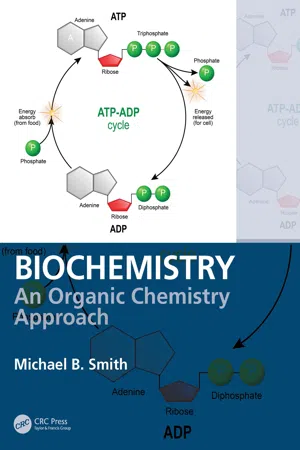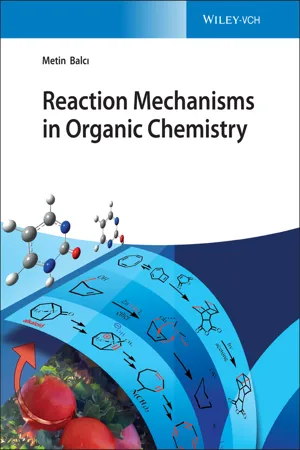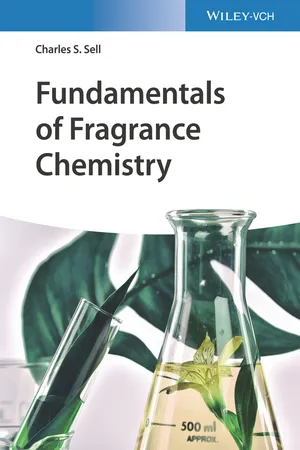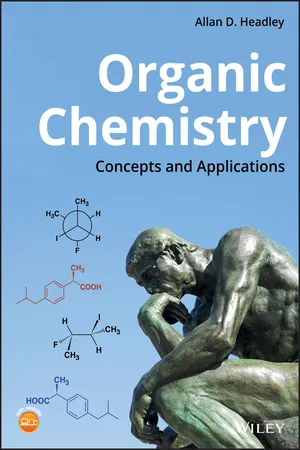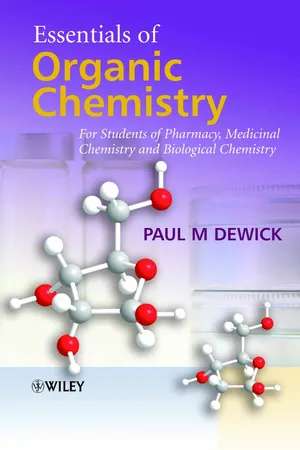Chemistry
Electrophile and Nucleophile
Electrophiles are electron-deficient species that seek to accept a pair of electrons, typically through a reaction with a nucleophile. Nucleophiles, on the other hand, are electron-rich species that donate a pair of electrons to form a new chemical bond with an electrophile. In chemical reactions, electrophiles and nucleophiles play crucial roles in determining the direction and outcome of the reaction.
Written by Perlego with AI-assistance
Related key terms
Related key terms
1 of 4
Related key terms
1 of 3
7 Key excerpts on "Electrophile and Nucleophile"
- eBook - ePub
Biochemistry
An Organic Chemistry Approach
- Michael B. Smith(Author)
- 2020(Publication Date)
- CRC Press(Publisher)
3 Nucleophiles and ElectrophilesAliphatic substitution reactions are early examples of organic chemical reactions in a typical undergraduate organic chemistry course. Such reactions involve the reaction of nucleophilic species with an electrophilic species, and for the most part they follow first-order or second-order kinetics. There are nucleophiles that are prevalent in biochemical reactions, including alcohols, amines, and thiols. Substitution reactions in a typical organic chemistry course involve reactions at carbon that is connected to a heteroatom moiety such as a halogen leaving group. In biochemistry the leaving group is often a phosphonate ester or another biocompatible group. Another type of nucleophilic reaction involves carbonyl compounds, including acyl addition of ketone and aldehyde moieties and acyl substitution reactions of carboxylic acid derivatives.This chapter will briefly review the SN 2 and SN 1 reactions and then describe nucleophiles that are common in biochemical applications and the substitution reactions that are common for these nucleophiles. Nucleophilic reactions require electrophilic species. Electrophiles or electrophilic substrates are common in biochemistry, including phosphonate derivatives, carbonyl compounds and imine compounds. Any discussion of typical nucleophilic reactions also requires an understanding of such electrophilic substrates. The fundamentals of both acyl addition and of acyl substitution reactions will be presented for carbonyl electrophilic centers and the reactions of these electrophilic centers with nucleophiles.3.1 Nucleophiles and Bimolecular Substitution (the SN 2 Reaction)The SN 2 reaction is one of the seminal reactions in a typical undergraduate organic chemistry course. The reaction of 1-bromo-3-methylbutane with sodium iodide (NaI) using acetone as a solvent gave 1-iodo-3-methylbutane, in 66% yield.1 In terms of the structural changes, the iodide ion substitutes for the bromine, producing bromide ion (Br– ). Iodide reacted as a nucleophile in the reaction at Cδ+ of the alkyl bromide, breaking the C—Br bond and transferring the electrons in that bond to bromine. In molecules that contain the C—Br bond, or indeed a C—C bond, where X is a heteroatom-containing group, the carbon will have a δ+ dipole. In other words, the carbon atom is electrophilic, and the substrate that reacts with the nucleophile is called an electrophile. The reaction of a nucleophile with an aliphatic electrophile is formally called nucleophilic aliphatic substitution , illustrated in Figure 3.1 . The displaced atom or group (e.g., chloride), departs (leaves) to become an independent ion. Displacement of chlorine leads to the chloride ion (Cl– ), but the bromide ion, iodide ion, or a sulfonate anion also correlates to X, which is referred to as a leaving group . In many biochemical reactions, the leaving group is a phosphate, —O–PO2 - eBook - ePub
- Metin Balc?, Metin Balc?, Metin Balc?, Metin Balc?, Metin Balc?(Authors)
- 2021(Publication Date)
- Wiley-VCH(Publisher)
All elements in the fifth and sixth groups of the periodic table contain nonbonding electrons. All of these fall into the nucleophilic compound class because there are electrons in their outer shell and they react easily with electrophiles. For example, compounds such as amines, ethers, alcohols, and mercaptans are the most important representatives of this group. These compounds belong to the Lewis base group as well.Anions also fall into the nucleophile group because they are negatively (−) charged and react easily with electrophiles.Carbon–carbon double bonds are compounds in which the electron density is rich. They donate a pair of electrons as well. This not only covers double bonds but also triple bonds (alkynes) and even enols and enolates. Aromatic compounds are electron-rich compounds because they have π electrons that are freely delocalized. As these compounds react easily with electrophiles, they are also considered nucleophiles.1.4 Inductive and Mesomeric Effects
1.4.1 Inductive Effect
In the introductory section, we emphasized that the inductive and mesomeric effects should be learned very well in order to understand the reaction mechanisms and the estimation of possible reaction products, etc., because these are the factors that directly determine and affect the electron density in various regions of the molecule. In symmetrical σ bonds (bonds formed between the same atoms), the electron density is equally distributed between the two atoms because they have the same tendency to attract the bonding electrons. For example, in compounds such as hydrogen, chlorine, bromine, and ethane, the bond electrons are not polarized; they are homogeneously distributed between the two atoms.If atoms are different from each other, bond electrons are attracted more strongly by one of the atoms and the distribution of the electron density varies. Let us consider a σ bond that binds A and B atoms. If atom A is more electronegative than atom B, A will attract electrons toward itself and will decrease the electron density around atom B, while the electron density around A will increase. A polar bond is a covalent bond in which there is a separation of charge between one end and the other. One end of the bond is slightly positively polarized and the other slightly negatively polarized. Partial charges are indicated by “δ” (delta). The signs δ+ and δ - eBook - ePub
- Charles S. Sell(Author)
- 2019(Publication Date)
- Wiley-VCH(Publisher)
centre is a hydroxyl ion, then the result will be neutralisation of the acid, but if the electron‐rich species is the oxygen atom of a ketone, then a different train of events will be set in motion. Similarly, a hydroxide ion could react with the electron‐poor proton of an acid, but it could also react with the electron‐deficient carbonyl carbon of an ester. The acidic/electrophilic and basic/nucleophilicbehaviour of species is always in balance. The position of this balance can be affected by the nature of the species it is reacting with and by other factors such as the solvent.Electrophiles and nucleophiles are classified as hard (not polarisable) and soft (polarisable). If the charge clouds around them are easily distorted, they are said to be polarisable since the charge distribution will change as the orbitals are distorted. Soft electrophiles prefer to react with soft nucleophiles and hard with hard. Thus, this phenomenon also helps determine whether a species acts as a base/nucleophile or as an acid/electrophile.As was discussed in previous chapters, the electrons in a bond between two dissimilar atoms are not shared equally between these atoms. The atom with the higher number of protons in its nucleus will tend to pull electrons away from the other atom and therefore build up a negative charge over itself, leaving a partial positive charge over the other atom. For example, oxygen or chlorine atoms will draw electrons away from a carbon atom to which they are attached, making the oxygen or chlorine end of the bond slightly negatively charged and the carbon end slightly positively charged. This effect can extend along to the next bond in a chain also. It is known as the inductive effect.In Figure8.8, we see how the hydroxide ion can act as either a base or a nucleophile. At the top of the figure is a drawing of an ester function showing how the carbon–oxygendouble bond is polarised with a partial negative charge on the oxygen atom and a partial positive charge on the carbon. The positive charge on the carbon has an effect on the hydrogen atoms on the adjacent carbon and makes them slightly positive also, as shown in the figure. If the hydroxide ion approaches the α‐hydrogens, it can act as a base by removing one of these to form the carbanion shown in the left of the figure. Alternatively, as shown on the right of - eBook - ePub
Organic Chemistry
Concepts and Applications
- Allan D. Headley(Author)
- 2019(Publication Date)
- Wiley(Publisher)
2 S. For nucleophiles, typically there is only one atom, which is the nucleophilic atom and that is the atom with the unshared pair of electrons, examples are shown below.Problem 15.3
Which of the following molecules are electrophiles and which are nucleophiles? For each electrophile identified, indicate the electrophilic atom and for the nucleophile, identify the atom with the unshared pair of electrons.15.5 Nucleophilic Substitution Reactions
As the name suggest and as mentioned in Chapter 6 , the nucleophilic substitution reaction involves a nucleophile reacting with an electrophile in which the leaving group in the reactant is substituted by the nucleophile to form a product. The general feature of a nucleophilic substitution reaction is shown in Reaction (15‐10) .(15‐10)An example of a nucleophilic substitution reaction is shown in Reaction (15‐11) , which involves the reaction of chloroethane and hydroxide anion.(15‐11)You should be able to identify some important species of Reaction (15‐11) ; the first is the electrophile in the reaction. After you have identified the electrophile, you should be able to identify the electrophilic atom. Next, you should be able to identify the nucleophile. Once the nucleophile has been identified, you should be able to identify the nucleophilic atom and the unshared pair of electrons that are used to form the new bond in the product. The next is the leaving group that is typically bonded to the electrophilic atom of the electrophile, in this case, chlorine is the leaving group since it is substituted for an OH in the product and it is a stable anion (weak base). You should recognize that a major driving force for these substitution reactions to occur is that owing to the partial positive character of the electrophilic carbon of electrophiles, an attraction of the unshared pair of negative electrons and the nucleophile occurs and in the process the leaving group leaves. Thus, a reaction between a nucleophile and an electrophile is favorable because these species have opposite charges (or partial charges) and opposite charges (or partial charges) always attract each other. In the process of the reaction, the leaving group leaves because it can accommodate a formal negative charge (or a neutral molecule in some cases, as we have seen with H2 O and R3 N). Shown in Reactions 15‐12 and 15‐13 - eBook - ePub
- Edwin Vedejs, Scott E. Denmark(Authors)
- 2016(Publication Date)
- Wiley-VCH(Publisher)
* interactions will be covered.4.2 Nucleophilicity
4.2.1 The Swain–Scott and Edwards Approaches
The development of concepts aiming at understanding reactivity in organic chemistry can be traced back to the late 1920s, when Ingold introduced the terms “electrophile” and “nucleophile” for reactive organic species, characterized by a lack or surplus of electrons, respectively [1]. Since then, many efforts have been made to quantify the electrophilicity and the nucleophilicity of organic compounds. In this context, attempts have been made to build reliable scales of reactivity.In 1953, Swain and Scott proposed the linear free energy relationship depicted in Eq. (4.1) and applicable to SN 2 reactions. In this equation, k is the bimolecular rate constant for a given electrophile reacting with a given nucleophile, k0 is the rate constant of the reaction of the electrophile with water, s characterizes the sensitivity of an electrophile to variations in the nucleophile, while n characterizes the nucleophilicity of a nucleophile. Methyl bromide was chosen initially as a reference electrophilic substrate (s = 1.00) and water was taken as the standard nucleophile (n = 0) [2].(4.1)One year later, Edwards proposed a four-parameter linear free energy relationship, based on the assumption that the nucleophilicity depends on the basicity and the polarizability of the nucleophile (Eq. (4.2) ) [3].(4.2)In this equation, P and H denote the polarizability and basicity of nucleophiles, respectively, while A and B are substrate parameters representing the sensitivity of the reactions to changes in these two quantities, that is, polarizability and basicity, respectively. The parameter H is derived from pKa values (H = pKa + 1.74) and the parameter P is determined from refraction measurements (P = log (R∞ /RH2O )), where R∞ and RH2O are the molar refractions of the reagent and of water.In some instances, the application of Eq. (4.2) was found to give better fits than the Swain–Scott analog but an extensive use of this correlation was precluded because of the difficulty in determining reliable Edwards parameters. Thus, keeping with the Swain–Scott correlation, Pearson et al. could determine the nucleophilicity parameters for various nucleophiles using methyl iodide as a reference electrophile (nMeI ) and methanol as a standard nucleophile [4]. Values of the nMeI parameter for a variety of nucleophiles are given in Table 4.1 . Interestingly, Pearson et al. found that Eq. (4.1) - eBook - ePub
- Robert J. Ouellette, J. David Rawn(Authors)
- 2015(Publication Date)
- Elsevier(Publisher)
equilibrium constant for an acid–base reaction between the hydrogen atom of the haloalkane and the nucleophile in an elimination reaction.The nucleophilicities and basicities of a series of structurally or chemically related nucleophiles such as halide ions, oxygen-containing anions, and sulfur-containing anions are not always related in a simple way. However, trends are evident based on periodic properties of the elements. Table 7.1 gives the relative rates of the reaction of various nucleophiles with iodomethane.Table 7.1 Relative Rates of Reaction of Nucleophiles with IodomethaneNucleophile Relaitive Rate CH3 OH 1 NO3 − 30 F− 5 × 102 SO4 − 2 3 × 103 CH3 CO2 − 2 × 104 Cl− 2.5 × 104 NH3 3.2 × 105 N3 − 6 × 105 Br− 6 × 105 CH3 O− 2 × 106 I− 2.5 × 107 CH3 S− 1 × 109 Trends in Nucleophilicity Within a Period
For a group of nucleophilic ions derived from elements in the same period of the periodic table, the nucleophilicity and basicity parallel each other and decrease from left to right in the period. Thus, methoxide ion is both more basic and more nucleophilic than fluoride ion (Table 7.1 - eBook - ePub
Essentials of Organic Chemistry
For Students of Pharmacy, Medicinal Chemistry and Biological Chemistry
- Paul M. Dewick(Author)
- 2013(Publication Date)
- Wiley(Publisher)
In addition, since the halide is attached to carbon through an sp 2 -hybridized bond, the electrons in the bond are considerably closer to carbon than in an sp 3 -hybridized bond of an alkyl halide (see Section 2.6.2). Lastly, resonance stabilization in the halide gives some double bond character to the C–Hal bond. This effectively strengthens the bond and makes it harder to break. This lack of reactivity is also true for S N 1 reactions (see Section 6.2). 6.1.2 Nucleophiles: nucleophilicity and basicity The S N 2-type reaction can be considered simply as being initiated by attack of a nucleophile onto the electron-deficient end of a polarized bond X–Y. If X = H, then this equates to removal of a proton and we would consider the nucleophile to be a base (see Section 4.1). It follows that there is going to be a close relationship between a group’s capacity to act as a nucleophile, i.e. nucleophilicity, and its ability to act as a base, i.e. basicity. Thus, the hydroxide ion can act as a nucleophile or as a base. In many cases, nucleophilicity can be correlated with basicity, and this forms a helpful way of predicting how good a potential nucleophile may be. The sequences of relative basicity given in Table 6.2 are also reflected in relative nucleophilicities. The approximation works best for comparisons where the identity of the attacking atom is the same, e.g. N, or O, as illustrated in Table 6.2. Table 6.2 Nucleophilicity and basicity with N and O nucleophiles The correlation is useful but not exact. This is because basicity is a measure of the position of equilibrium between a substrate and its conjugate acid (see Section 4.4), whereas nucleophilicity relates to a rate of reaction. The above relationship breaks down when one looks at atoms in the same column of the periodic table. As atomic number increases, basicity decreases, whilst nucleophilicity actually increases (Table 6.3)
Index pages curate the most relevant extracts from our library of academic textbooks. They’ve been created using an in-house natural language model (NLM), each adding context and meaning to key research topics.
Explore more topic indexes
Explore more topic indexes
1 of 6
Explore more topic indexes
1 of 4
